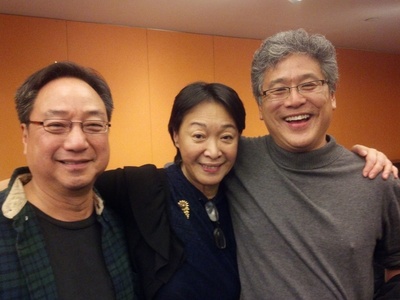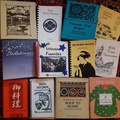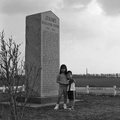Two months after the Japanese attacked Pearl Harbor in 1941, President Franklin D. Roosevelt issued Executive Order 9066, forcing between 110,000 and 120,000 people of Japanese descent to live behind the barbed-wire fences of internment camps.
In 1943 all interned Japanese Americans over the age of 17 completed the Application for Leave Clearance, commonly known as the “loyalty questionnaire,” as required by the US War Department and the War Relocation Authority (WRA). Based on the answers, the WRA determined who was “loyal” or “disloyal” and segregated the internees accordingly. Two questions were particularly important to the WRA:
Question #27
Are you willing to serve in the armed forces of the United States on combat duty, wherever ordered?
Question #28
Will you swear unqualified allegiance to the United States of America and faithfully defend the United States from any and all attack by foreign or domestic forces, and forswear any form of allegiance to the Japanese Emperor or any other foreign government, power, or organization?
Of the young men who answered “Yes,” many went on to join the US military, serving in exemplary fashion with the 100th Infantry Battalion, the 442nd Regimental Combat Team, and the Military Intelligence Service.
Those who answered “No” to both questions were deemed disloyal by the US government and were sent to the Tule Lake internment camp in California. They were later referred to as “No-No Boys” and faced ostracism from people within their own communities.
The concept of the “No-No Boy” was the subject of recent play readings held by Pan Asian Repertory. JapanCulture•NYC is delighted that guest writer Tamio Spiegel attended the readings and filed this report.
* * *
On November 16 and 17, Pan Asian Repertory hosted two public readings of Ken Narasaki’s play, No-No Boy, as part of the organization’s development series, “Plays in Progress.”
This event comes as Pan Asian Repertory begins its historic 36th Season of presenting theatrical works by and about the Asian American community.
Based on the novel by John Okada and set in post-WWII Seattle, the play follows draft resistor Ichiro Yamada after he is released from prison and struggles to come to terms with the consequences of his choices, while the rest of the community tries to get back on its feet.
The script was read by nine actors playing nineteen characters and stage directions before enthusiastic, curious, and thoughtful guests. Following the complete reading of the play, the audience engaged in conversation with Pan Asian Artistic Director Tisa Chang, playwright Narasaki, and director Ron Nakahara about the play, its characters, and the issues the play brings to the fore.
Many in the audience were curious about the source material and Narasaki’s choice to develop the novel into a play.
“I read [the novel] and it blew my mind…,” Narasaki told the audience. “These guys were my parents, and they’re, like, drinking and misbehaving and they’re going, ‘What the hell am I living for?’ … They were 18, 19, 20 years old and they’re faced with these life-changing decisions. [The consequences] would last, literally, for a lifetime. The book always stayed with me.”
When director Nakahara first saw the script, it had immediate appeal to him.
“It’s a story I never saw before,” he says. “We did a lot of camp plays and they were all, basically, the same play—the same story. But this one about the No-No Boys was like a secret within a secret. Just that alone is very interesting, but I have an affinity for this kind of writing—stream of consciousness.”
The play opens after World War II has ended, so the protagonist’s decision to resist the draft is not significantly portrayed within the current script. Some in the audience sought more clarity about that decision and how the character came to make it. Narasaki conceded that it is an issue with some audiences, but Nakahara expressed clearly that it was not an issue for him.
“It’s not a play about the decision to sign ‘No-No.’ That’s not the play. The play is about what happens to people after they have been incarcerated,” says Nakahara.
Both writer and director were drawn to the stream-of-consciousness style of the original novel, which, while appealing, presented issues translating the source material to a play format.
“A lot of [the novel] was an omniscient point of view, and a lot of the dialogue was inside his head,’ says Narasaki. “But, the writing was so beautiful. I started assigning some of the lines to different characters, and some of the arguments he was having with himself became arguments he has with his friends.”
Nakahara embraced the challenges. “The play, in my mind, would have a very fluid staging and delivery. In terms of how it would be set and staged, it would be very minimal. It’s a very dark play.”

L-R: Ron Nakahara, Director; Tisa Chang, Pan Asian Repertory Artistic Director; Ken Narasaki, Playwright. Photo by Tamio Spiegel
For their first project opening their 36th season, Pan Asian Repertory has taken a bold adaptation of an overlooked Japanese American novel and given it voice and form. This bodes well for the coming season.
As for No-No Boy, one hopes that Pan Asian Repertory’s reading will bring more awareness of Japanese American draft resistors during World War II, the community’s reaction to them, then and now, as well as overdue attention to the novel and Narasaki’s adaptation.
*This article was originally published on JapanCulture•NYC.com on November 21, 2012. On November 29 Tamio and his wife, Julie Azuma, will be honored by Pan Asian Repertory for their dedication and service. Click here for details.
© 2012 Tamio Spiegel






